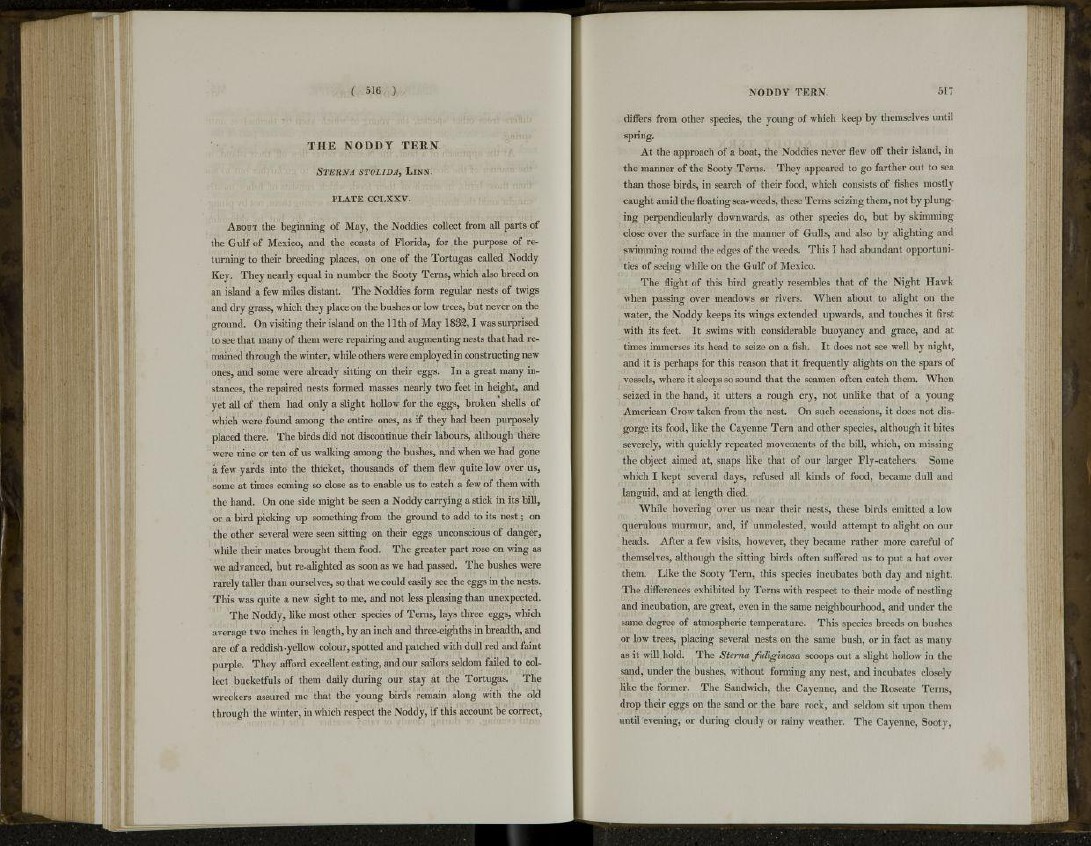
( 516 )
THE NODDY TERN.
STERNA STOLIDA, LINN,
PLATE CCLXXV.
ABOUT the beginning of May, the Noddies collect from all parts of
the Gulf of Mexico, and the coasts of Florida, for the purpose of returning
to their breeding places, on one of the Tortugas called Noddy
Key. They nearly equal in number the Sooty Terns, which also breed on
an island a few miles distant. The Noddies form regular nests of twigs
and dry grass, which they place on the bushes or low trees, but never on the
ground. On visiting their island on the 11th of May 1832,1 was surprised
to see that many of them were repairing and augmenting nests that had remained
through the winter, while others were employed in constructing new
ones, and some were already sitting on their eggs. In a great many instances,
the repaired nests formed masses nearly two feet in height, and
yet all of them had only a slight hollow for the eggs, broken shells of
which were found among the entire ones, as if they had been purposely
placed there. The birds did not discontinue their labours, although there
were nine or ten of us walking among the bushes, and when we had gone
a few yards into the thicket, thousands of them flew quite low over us,
some at times coming so close as to enable us to catch a few of them with
the hand. On one side might be seen a Noddy carrying a stick in its bill,
or a bird picking up something from the ground to add to its nest; on
the other several were seen sitting on their eggs unconscious of danger,
while their mates brought them food. The greater part rose on wing as
we advanced, but re-alighted as soon as we had passed. The bushes were
rarely taller than ourselves, so that we could easily see the eggs in the nests.
This was quite a new sight to me, and not less pleasing than unexpected.
The Noddy, like most other species of Terns, lays three eggs, which
average two inches in length, by an inch and three-eighths in breadth, and
are of a reddish -yellow colour, spotted and patched with dull red and faint
purple. They afford excellent eating, and our sailors seldom failed to collect
bucketfuls of them daily during our stay at the Tortugas. The
wreckers assured me that the young birds remain along with the old
through the winter, in which respect the Noddy, if this account be correct,
NODDY TERN. 517
differs from other species, the young of which keep by themselves until
spring.
At the approach of a boat, the Noddies never flew off their island, in
the manner of the Sooty Terns. They appeared to go farther out to sea
than those birds, in search of their food, which consists of fishes mostly
caught amid the floating sea-weeds, these Terns seizing them, not by plunging
perpendicularly downwards, as other species do, but by skimming
close over the surface in the manner of Gulls, and also by alighting and
swimming round the edges of the weeds. This I had abundant opportunities
of seeing while on the Gulf of Mexico.
The flight of this bird greatly resembles that of the Night Hawk
when passing over meadows or rivers. When about to alight on the
water, the Noddy keeps its wings extended upwards, and touches it first
with its feet. It swims with considerable buoyancy and grace, and at
times immerses its head to seize on a fish. It does not see well by night,
and it is perhaps for this reason that it frequently alights on the spars of
vessels, where it sleeps so sound that the seamen often catch them. When
seized in the hand, it utters a rough cry, not unlike that of a young
American Crow taken from the nest. On such occasions, it does not disgorge
its food, like the Cayenne Tern and other species, although it bites
severely, with quickly repeated movements of the bill, which, on missing
the object aimed at, snaps like that of our larger Fly-catchers. Some
which I kept several days, refused all kinds of food, became dull and
languid, and at length died.
While hovering over us near their nests, these birds emitted a low
querulous murmur, and, if unmolested, would attempt to alight on our
heads. After a few visits, however, they became rather more careful of
themselves, although the sitting birds often suffered us to put a hat over
them. Like the Sooty Tern, this species incubates both day and night.
The differences exhibited by Terns with respect to their mode of nestling
and incubation, are great, even in the same neighbourhood, and under the
same degree of atmospheric temperature. This species breeds on bushes
or low trees, placing several nests on the same bush, or in fact as many
as it will hold. The Sterna fuliginosa scoops out a slight hollow in the
sand, under the bushes, without forming any nest, and incubates closely
like the former. The Sandwich, the Cayenne, and the Roseate Terns,
drop their eggs on the sand or the bare rock, and seldom sit upon them
until evening, or during cloudy or rainy weather. The Cayenne, Sooty,